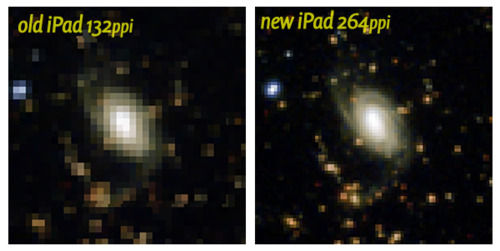The deep cosmos at 264 pixels per inch a monster astrophoto on the new iPad
Last week astronomy Phil Plait blogged about an an ultradeep image that’s full of galaxies — a monster 17,000×11,000 pixel picture crammed with points and patches of light, all but a handful of which are entire galaxies — more than 200,000 of them. It’s “the single deepest infrared picture of the sky ever taken with this field of view.” It’s a .0004% slice of sky, just 1.2×1.5˚. Yow. (Here’s the original ESO announcement. I also have versions ideally cropped for iPad display at the end of this.)
When I saw that massive high-resolution rendering of the gobsmacking, mind-buggering epicnesstitude of the cosmos, naturally the first thing I thought of was how it would look on my new high-resolution iPad, and how it would compare to my two-year old original iPad with it’s pathetic “low” resolution. (I’ve done cosmos-awe lots already. Old news!) The new iPad should show double the detail of previous iPads. And when most of the detail is high contrast points of light?
They should really shine! This astrophoto is pure detail.
Skipping right to the results, here’s a zoomed-in comparison. Don’t just look at the comparison here on the post page (which has much too narrow a column for this job): zoom in more (~210KB, 1200 pixels wide). And if you’ve got a big pipe, I also made an even bigger one (~660KB, 1664 pixels wide).

I downloaded the huge 250MB file from the ESO, resampled it at the new iPad’s resolution, and then cropped out an exactly-iPad sized image displaying the maximum possible detail from the largest section possible from the huge original. Then I created a duplicate and resample and resized it to half the resolution and dimensions: the same field of view, but exactly half the detail.
(Why didn’t I just load and show the full image, with the limits of the device imposed on it? The file was just too huge. There were issues.)
That gave me what I needed for the real-life comparison, and all I can say is, wow: with an image like this, where resolution is information, double resolution is not just really purty but also meaningful. There’s more of what makes the picture matter, literally. I’m definitely impressed.
And since the display is roughly at the limit of the human eye to perceive, this is also about as good as it’s ever going to get. I have been interested in both astrophotography and computers for most of my life. One of the first things I ever did with a computer, in the early 80s, was to program a star field — on an old colour TV with pixels as big as golf balls. I have been waiting ever since for a computer display that could show me stars in as much detail as a good printed photo. Technically speaking, even this new iPad is still not there … but it’s so much closer to the goal that I don’t care. It’s like finishing the last half of a marathon in one lunge. Quality differences past this point are going to be pretty subtle.
This difference is not subtle. Not to me.
Here’s a nice detail where the difference is glaring: a spiral galaxy close to the limit of the new iPad’s power to reveal … but totally beyond the old iPad’s resolution. There simply is no spiral to see at the lower resolution, except the roughest hint of an arm at the upper left. And even that would disappear on most computer displays.

Those comparison collages were actually pretty tricky to make.
Resolution and resampling math is always a bit of a brain teaser, even when it’s just a clean doubling. And the original image is large enough to be really quite awkward to work with. For instance, the current version of Adobe Fireworks (which I use because I produce a lot of web graphics) was just humiliated: its resize feature doesn’t do >10,000, eyeroll. Pixelmator was up to it, but with biggish pauses for every operation — and I did a lot of trial and error. So it was tedious even on a really, really good iMac (I’m running a 3.4 GHz Intel Core i7).
There was a confusing detour when I first transferred the images to my iPads via Dropbox. They looked identical, but I assumed I’d done something wrong, and I did a lot of head scratching and messing about with resampling before I finally realized that Dropbox was dialing the big photo down to old iPad resolution! Thanks a lot, Dropbox! (Presumably that was a sensible optimization feature before the new iPad. Why download pixels you can’t show?) When I finally transferred the photos via Photo Stream instead … boom, instantly obvious quality difference.
All good geek fun! What a great way to spend a Sunday morning!
Here’s the (cropped) photos, tuned for…
- the old iPad — 1024×768 @ 131ppi, 1.4MB
- the new iPad — 2048×1536 @ 264ppi, 5.5MB
Note that file size delta.☺Yes, the high-density display era is definitely going to require more bandwidth.
Original image credit: bow down to the ESO/UltraVISTA team. Acknowledgement: TERAPIX/CNRS/INSU/CASU.